You are currently browsing the yearly archive for 2008.
Part 2: Hijacking What It Means to Be Human
(Read Part 1 to learn about mentalists, skeptics and cold reading.)
Imagine my surprise when I discovered there are at least a half-dozen extremely expensive books marketed by mentalists on tarot, of which I’d never heard in my forty-plus years collecting tarot books. And, they were written by and for professional tarot readers that I didn’t even know existed as a self-identified group. Of course, I was aware there are fraudulent tarot readers who deliberately used cold reading techniques to con their marks. Naively, I had assumed, though, that cold reading was used mostly by fake mediums and clairvoyants (as in the 19th century) and by mentalist entertainers. I had no idea that tarot was regularly taught as a scam except among some phone psychics and those storefront psychics who used it to extort money for removing curses, etc.—a whole different, albeit related, enterprise. [Note: some mentalists are also ethical tarot readers, and not all mentalists deny the paranormal. I am also not referring, in most of what follows, to ethical mentalists who are honest about using mental tricks.] Read the rest of this entry »
Rachel Mann of Washington D.C. has given me permission to post her “Practical Tree of Life Spread” that she first presented on Aeclectic Tarot’s tarotforum. She found most versions to be too abstract or attempting to cover too much, so she simplified it, resulting in a easy, accessible bare bones approach. Having tried dozens of Tree of Life spreads in the past, this one has quickly become my favorite.
Like the Celtic Cross you say the card position keywords as you lay cards down using the words in the illustration. The numbers represent the order in which you lay out the cards and read them. (They are not the numbers associated with the sephiroth.)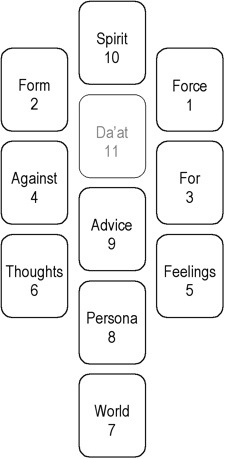
Here’s more about the positions:
Positions 1 & 2 – Force and Form represent “The Issue.” You can see Force as a generative, active energy behind the issue and Form as the form or structure the issue takes. (They can also represent two alternatives or choices.)
Positions 3 & 4 – People or things going for or against you. (They can also express what’s expanding and contracting, or what’s coming in and going out.)
Positions 5 & 6 – Your feelings and thoughts.
Position 7 – World. Your body, possessions, physical manifestations.
Position 8 – Persona. Your everyday self and how you present yourself.
Position 9 – Advice. Your heart’s advice. The best you can do.
Position 10 – Spirit. Morality or personal growth related to the issue.
Da’at (optional card) – If you choose you can also lay out an additional card between cards 9 and 10. The Da’at (meaning ‘Knowledge’) Position can represent a shadow or hidden knowledge: something unknown or a possible future. It can bring insight, especially as to how to integrate the cards on the right and left pillars.
You work your way down the tree with cards in positions 1 through 6 on the left and right pillars. Then, work your way up the middle pillar from position 7 at the bottom to 10 at the top. Rachel adds: “I really feel the grouping and order are important to get the right flow for the reading, especially ending by going up the middle pillar. A good way to sum up a reading is to consider how the middle pillar cards (7 and 8 ) align with the upper ones (9 and 10).”
The New York Times reporter Ruth La Ferla has written an article, “Love, Jobs & 401(k)s” about the popularity of psychics (including tarot readers) in the economic downturn. It seems that business is booming in this profession. La Ferla quotes one stock trader as saying, ““When conditions are this volatile, consulting a psychic can be as good a strategy as any other.” To which she responds that when the Treasury secretary changes his mind weekly “a good set of tarot cards might come in handy.” Read the rest of this entry »
I experienced a breakthrough regarding tarot when I realized that all the Major Arcana cards are operating somewhere within me at all times. I discovered this from doing a variety of twenty-two card spreads that show where each energy or archetype is operating at the moment. Of course some cards are emphasized or highlighted around particular issues. These are the ones that show up in smaller spreads saying: “Look at me. I’m what’s most important right now regarding your question.” It’s kind of like they’re doing a jig or vibrating more than the others, and thrusting themselves to the front to get your attention. Meanwhile, the others are in the background, quietly doing their own thing or maintaining the status quo.
Sometimes it’s worth seeing the whole picture to understand how each energy or archetype plays its role in relation to the others. There are several ways to do this. Read the rest of this entry »
Warning: the following is a political, social commentary by Keith Olbermann prompted by the passage of Prop.8 in California, which rescinded the right of same sex couples to marry. I found it a beautiful and impassioned plea for humanity’s honoring of the deepest meaning of the Lovers card. The title above is a line from the poet Omar Khayyam quoted by Olbermann.
I just couldn’t resist this photo from the 1997 BBC Hamish Macbeth series (Season 3) based on the mystery stories by M.C. Beaton. Here’s Robert Carlyle as Hamish on a cliff edge, being “hounded” by his faithful companion, Jock. If you like British “cozies” and stories of the wise-fool then you’ll love this series. And, if that’s not enough, in Beaton’s most recent Hamish Macbeth book, Death of a Gentle Lady, he’s referred to several times as a fool.
 Dan Pelletier consulted the tarot before heading from his home in Seattle to New York to train for a new job. The cards told him he would come home a changed man. On the second morning of training he got an overwhelming urge to go out for a cigarette. The training was on the 61st floor of Twin Tower 2 and it was 9/11. Dan watched others die while he inexplicably escaped the falling debris, beginning an odyssey that, soon after, led to his leaving the financial industry to follow his heart and do what makes him feel whole. Dan is now co-owner with Jeannette Roth of Tarot Garden, Inc., a shop and information site dedicated to helping you find the tarot decks that interest you. He’s been reading tarot for over thirty years and credits some kind of other-worldly sense with guiding and saving his life more than once. As Umbrae, he frequently posts on Aeclectic’s tarotforum. Read the rest of this entry »
Dan Pelletier consulted the tarot before heading from his home in Seattle to New York to train for a new job. The cards told him he would come home a changed man. On the second morning of training he got an overwhelming urge to go out for a cigarette. The training was on the 61st floor of Twin Tower 2 and it was 9/11. Dan watched others die while he inexplicably escaped the falling debris, beginning an odyssey that, soon after, led to his leaving the financial industry to follow his heart and do what makes him feel whole. Dan is now co-owner with Jeannette Roth of Tarot Garden, Inc., a shop and information site dedicated to helping you find the tarot decks that interest you. He’s been reading tarot for over thirty years and credits some kind of other-worldly sense with guiding and saving his life more than once. As Umbrae, he frequently posts on Aeclectic’s tarotforum. Read the rest of this entry »
What deck, created two years ago by the versatile Filipino artist, Lynyrd Narciso, predicted the ascendancy of a certain unknown to national prominence? Name not only the deck and the person, but tell us what symbols in the card gave it away. Anyone use this deck? If so, what do you think of it? [Thanks to Lynn Araujo.]
Enough of you have figured it out, so I’ll let everyone know. This is the Vanessa Tarot by Lynyrd Narciso (2006, U.S. Games Systems, Inc.). The people (mostly female) have big heads and doe’s eyes like the BRATZ dolls that swept the international market a couple of years ago. Illustrations feature plenty of visual references to pop culture and fairy tales and have the same mix of adult themes and pre-teen dreams that you’ll find on TV and in the movies, including a multi-cultural cast of women scientists, warriors, judges, princesses and bartenders, and a few guys. This “cute” deck offers far more than you might think on first look. Here’s a review by Dan Pelletier.
The three-card spread is one of the most basic formats for quick-and-easy tarot readings. Yet, it can be surprisingly deep and insightful. It is perfect for a daily journal or when friends or people at parties want you to demonstrate what you do. Furthermore, the three-card spread is amazingly flexible as I hope to demonstrate. Most of these spreads are laid out in a row, left to right, although any pattern is fine.
Updated!! Check out some new spreads at the end.
Probably everyone is familiar with the basic timeline spread:
- PAST
- PRESENT
- FUTURE
Most of you will have used the following inner trinity for a quick diagnostic as it shows what’s going on at three levels of experience:
- BODY
- MIND
- SPIRIT
An interesting variation on this is:
- HEAD – What does my Head want?
- HEART – What does my Heart want?
- SOUL – What does my Soul want?
Three-card readings are also great for evaluating potential actions. To compare options lay out a three-card spread for each possibility: The Pro-or-Con Spread:
- The PRO or BENEFIT of a particular choice or action.
- The CON or LIABILITY in that choice or action.
- SOMETHING ELSE you need to take into account.
This can also help you deal with problems via the dialectic imperative: The Thesis Spread:
- THESIS, idea or issue
- ANTITHESIS, obstacle or problem
- SYNTHESIS, integration or solution
Zoe Matoff came up with a more prescriptive version of this that is brilliant when you want to cut through all the nuances and get a (relatively) straight answer with “Zoe’s Do/Don’t Do Spread” (a favorite of both Rachel Pollack and myself):
- Card 2: DON’T DO THIS
- Card 1: The ISSUE or SITUATION
- Card 3: DO DO THIS
Zoe wrote me this explanation of her spread: “Often cards two and three will describe such disparate courses of action as to make it very clear what course of action needs to be taken or what decision is to be made. And, of course, card #1 can turn out to be a total surprise, delineating the situation as it really is, or in a light in which the questioner has not yet seen it, or a totally different situation that requires attention but has been overlooked. Last, but not least, all the cards need to be seen together to make clear the urgency or nature of the issue.”
Three-card readings form the basis of all the more complicated relationship readings: The Relationship Spread:
- PERSON A (is, wants, needs, gives, receives, etc.)
- THEIR RELATIONSHIP (as if it were it’s own entity)
- PERSON B (is, wants, needs, gives, receives, etc.)
And, as I was reminded by James Ricklef in the Comments, they are the core of choice spreads: The Choice Spread:
- CHOICE A
- OTHER considerations
- CHOICE B
Three-card spreads are also great for simple Yes/No questions: The Yes/No Spread:
Upright cards are yes.
Reversed cards are no.
The center card counts twice.
Thus, there can be a tie, which indicates that the answer is not yet determined, or it’s better not to know, or __?__. You can interpret the individual cards or not. (Any odd number of cards can be used.)
Inspired by John Gilbert, James Ricklef used this smart variation on the Yes/No Spread in his excellent book Tarot Reading Explained (originally Tarot Tells the Tale). (By the way, this is one of the best books available for learning how to read the cards. The “Yes, If” Spread features practical advice and entertaining examples that demonstrate the techniques.)
- YES, IF . . .
- NO, IF . . .
- MAYBE, IF . . .
James adds: “The cards indicate the conditions under which the answer would be Yes, No, or Maybe. Thus the “Maybe” card can indicate a deciding factor or a decision or action that the querent has to make in order to arrive at the outcome s/he wants.”
You can find many more examples of three-card spreads in James Ricklef’s book and in my own Tarot for Your Self, where the three-card spread is recommended for daily readings and developing a tarot journal.
Added: The Subject-Verb-Object Spread is good practice for integrating three cards into one statement: Jacob (subject) goes (verb) to the store (object). Alison loves Max. Day turns into night. Note: Your sentence may be much longer and more complex.
- SUBJECT: person, place or thing
- VERB: action or state of being, try an active verb here
- OBJECT or PREDICATE: goal, what’s affected or changed, recipient
Also, brought up from the comments: The Bridge Spread offered by Kyle McKenzie:
- Where I am
- Where I want to be
- How I can get there (placed horizontally between the first two cards)
Feeling overwhelmed with too much to do and not enough time? Thanks to Beth Maiden of Little Red Tarot for permission to share her handy Do One Thing Well Spread (click on the link for an example reading), which was new to me.
- Do this!
- Ditch this!
- Yeah, okay, but not until tomorrow
What’s your favorite Three-Card Spread? You’ll find several more Three-Card Spreads contributed by readers in the Comments section. Be sure to check these out, too, and add your own. Please remember to give credit where credit is due if you pass on any of these.

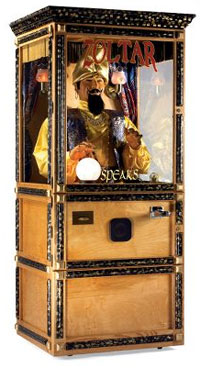
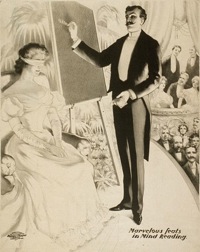
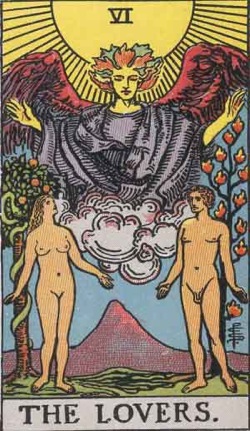
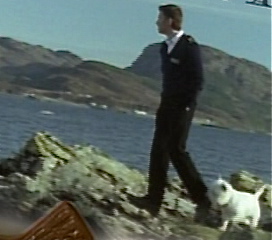
 Mary K. Greer has made tarot her life work. Check here for reports of goings-on in the world of tarot and cartomancy, articles on the history and practice of tarot, and materials on other cartomancy decks. Sorry, I no longer write reviews. Contact me
Mary K. Greer has made tarot her life work. Check here for reports of goings-on in the world of tarot and cartomancy, articles on the history and practice of tarot, and materials on other cartomancy decks. Sorry, I no longer write reviews. Contact me
Recent Comments